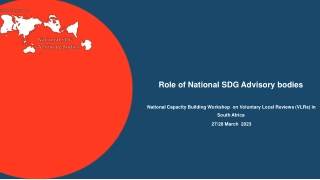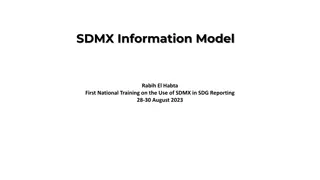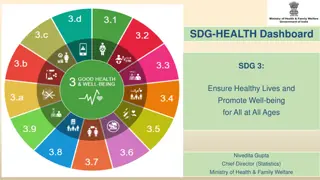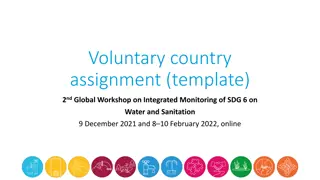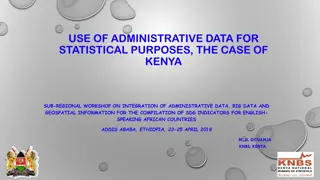Understanding SDG Data Structure Definition
SDG Data Structure Definition by Abdulla Gozalov, UNSD, developed by Working Group on SDMX for SDG Indicators. It includes dimensions like Frequency, Reporting Type, Series, and Reference Area. The single DSD supports diverse indicators, with annual frequency convention. Differentiates between National, Regional, Global Reporting, and represents indicators through series with distinct codes for each. Countries are encouraged to report national-level values with the option to extend to sub-national areas for dissemination.
Download Presentation

Please find below an Image/Link to download the presentation.
The content on the website is provided AS IS for your information and personal use only. It may not be sold, licensed, or shared on other websites without obtaining consent from the author. Download presentation by click this link. If you encounter any issues during the download, it is possible that the publisher has removed the file from their server.
E N D
Presentation Transcript
SDG Data Structure Definition Abdulla Gozalov, UNSD
SDG Data Structure Definition Developed by the Working Group on SDMX for SDG Indicators, which was established by the Interagency Expert Group on SDG Indicators (IAEG-SDGs) First meeting in October 2016 Draft release: Feb 2018 Pilot exchange: Apr Sep 2018 Official release: 14 Jun 2019 2
SDG DSD (contd) Single DSD used for all SDG indicators Support for diverse indicators means not all dimensions are applicable in all cases E.g. AGE is not applicable to indicator Land area covered by forest Value _T (no breakdown) is used when a dimension is not applicable. 3
Dimension: Frequency (FREQ) Indicates rate of recurrence at which observations occur (e.g. monthly, yearly, biannually, etc.). By convention, the SDG DSD currently only supports annual frequency. Where the frequency is not annual (e.g. two-year average), detail should be provided in the TIME_DETAIL attribute. 4
Dimension: REPORTING_TYPE Used to distinguish between National, Regional, Global Reporting Countries to use value N (national reporting) Regional organizations to use value R (regional reporting) Custodian agencies to use value G (Global reporting) 5
Dimension: Series (SERIES) Used to represent indicators A single indicator can have multiple series Not to be confused with SDMX time series E.g. 5.5.1 Proportion of seats held by women in (a) national parliaments and (b) local governments has 4 series: SG_GEN_PARL Proportion of seats held by women in national parliaments SG_GEN_PARLN Number of seats held by women in national parliaments SG_GEN_PARLNT Number of seats in national parliaments SG_GEN_LOCG Proportion of seats held by women in local governments 6
Dimension: Reference Area (REF_AREA) Country or geographic area to which the measured statistical phenomenon relates It is envisaged that countries will report national- level values but may wish to extend the code list with its sub-national areas for dissemination 7
Dimension: Sex (SEX) Gender condition: male or female. This dimension applies only if data can be disaggregated by sex. Use _T where not applicable For gender indicators must be set to F as applicable E.g. for series Proportion of seats held by women in national parliaments 8
Dimension: Age (AGE) Age - or age range - of the individuals the observation refers to. Use _T where not applicable 9
Dimension: Urban/Rural location (URBANISATION) Has 3 codes _T (Total) U (Urban) R (Rural) Use _T where not applicable 10
Dimension: INCOME_WEALTH_QUANTILE Used for disaggregating the data by income or wealth quintile of the population In the future can be extended to cover decile, percentile, etc Use _T where not applicable 11
Dimension: Education Level (EDUCATION_LEV) Highest level of an educational programme the person has successfully completed. Supports top categories of ISCED11 and ISCED97, as well as custom SDG codes Use _T where not applicable 12
Dimension: OCCUPATION Job or position held by an individual who performs a set of tasks and duties. Supports top categories of ISCO-08, ISCO-98, ISCO-68 Use _T where not applicable 13
Dimension: Disability Status (DISABILITY STATUS) Used to break down SDG indicators by disability At the moment, only used to distinguish between persons with a disability, and persons without a disability Use _T where not applicable 14
Dimension: Economic Activity (ACTIVITY) High-level grouping of economic activities based on the types of goods and services produced. Consists of top-level ISIC categories. Use _T where not applicable. 15
Dimension: Product Type (PRODUCT) Product or commodity code Combines SDG-specific entries from several classifications including CPC, Material Flows, and non-standard Use _T where not applicable 16
Dimension: Custom Breakdown (CUST_BREAKDOWN) Special dimension introduced to facilitate non-standard breakdowns, primarily in national context. Populated with generic codes (C01,C02, ), to which data providers will assign meaning in their own context Used in conjunction with attribute CUST_BREAKDOWN_LB, which transmits description of the custom code. Use _T where not applicable 17
Dimension: COMPOSITE_BREAKDOWN Mixed dimension: represents several merged code lists E.g. International Organizations, Hazard Type, etc Used for breakdowns that are only used in 1 or 2 indicators, in order to reduce sparsity (avoid creating too many dimensions) Use _T where not applicable 18
Time Dimension: TIME_PERIOD Timespan or point in time to which the observation actually refers. The convention for SDGs is to always provide a four-digit year in the TIME_PERIOD concept. Further info can be placed in TIME_DETAIL, and structured period information in TIME_COVERAGE. 19
Primary Measure: Observation value (OBS_VALUE) Used to convey the value of a variable at a period of time Should be a floating-point number 20
Attribute: Observation Status (OBS_STATUS) Information on the quality of a value or an unusual or missing value E.g. can be used to indicate a break in series Mandatory observation-level attribute 21
Attribute: Unit Multiplier (UNIT_MULT) Exponent in base 10 specified so that multiplying the observation numeric values by 10^UNIT_MULT gives a value expressed in the unit of measure If the observation value is in millions, unit multiplier is 6; if in billions, 9, and so on. Where the number is simple units, use 0. Mandatory observation-level attribute 22
Attribute: Unit of Measure (UNIT_MEASURE) Unit in which the data values are expressed It may not be obvious which is the correct unit in some cases. Coding guidelines are available and will be further developed. Mandatory time series-level attribute 23
Attribute: Nature of data points (NATURE) Information on the production and dissemination of the data (e.g.: if the figure has been produced and disseminated by the country, estimated by international agencies, etc.) Normally set to C (Country Data) in national reporting Optional observation-level attribute 24
Attributes: Footnotes (COMMENT_OBS and COMMENT_TS) Additional information on specific aspects of each observation, such as how the observation was computed/estimated or details that could affect the comparability of this data point with others in a time series. Attribute COMMENT_OBS is used for observation-level footnotes, and COMMENT_TS for time series-level footnotes. Both are optional. 25
Attribute: TIME_COVERAGE ISO8601 representation of the actual time interval to which the observation refers While TIME_PERIOD should always be expressed as a year, and TIME_DETAIL is free-text with additional information, TIME_COVERAGE can optionally be used to provide the exact interval in a structured format Optional observation-level attribute. 26
Attributes: UPPER_BOUND and LOWER_BOUND Where the observation value represents a point estimate, can be used to convey the Upper and Lower bounds In MDG DSD, separate series codes had to be created for upper and lower bounds Optional observation-level attributes 27
Attribute: Base Period (BASE_PER) Period of time used as the base of an index number, or to which a constant series refers Where a base period applies, it is expected to always be set to a year Typically used for constant prices, as in 2005 USD dollar Optional observation-level attribute. 28
Attribute: Time Period Details (TIME_DETAIL) When TIME_PERIOD refers to a date range, this attribute is used to provide metadata on the actual range the observation refers to (e.g. for period 2001-2003 TIME_PERIOD would be 2002 but the actual dates --2001-2003-- would be expressed here). Optional observation-level free-text attribute 29
Attribute: Source details (SOURCE_DETAIL) Provides additional textual information on the data source, e.g. a specific survey that was used to generate the indicator. Optional observation-level free-text attribute. 30
Attribute: GEO_INFO_URL Provides web address of a geoinformation file. Used in conjunction with attribute GEO_INFO_TYPE. Optional time series-level attribute. 31
Attribute: GEO_INFO_TYPE Specifies type of geoinformation file provided in attribute GEO_INFO_URL. Optional time series-level attribute. 32
SDG DSD: Mappings Due to its support for heterogeneous indicators, it s not always obvious which values should be used in some dimensions What should be SEX in indicator Births attended by skilled personnel : Not Applicable? Total? Female? 33
SDG DSD: Mappings (2) Inconsistent mappings lead to duplications and other anomalies Coding guidelines will be available and will be further developed and enforced through content constraints The use of a single code for no breakdown (e.g. for Total and Not Applicable) simplifies the mappings. 34
THANK YOU! 35




